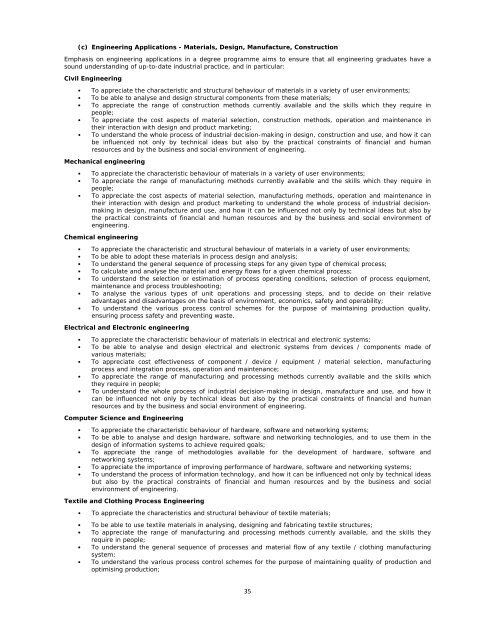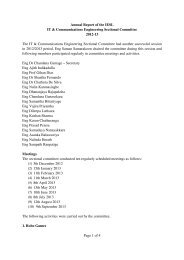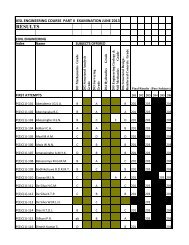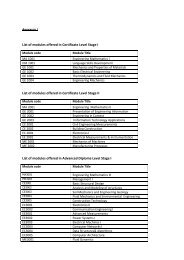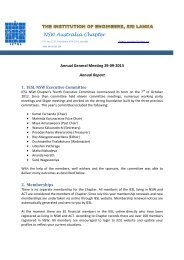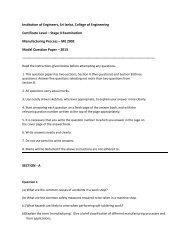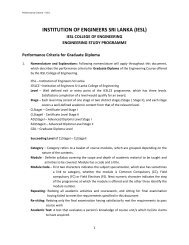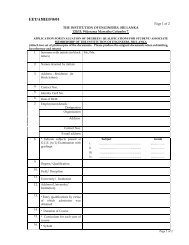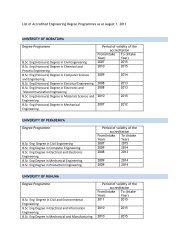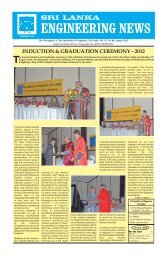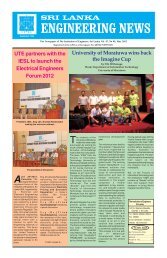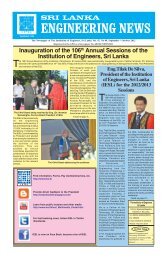1 - The Institution of Engineers Sri Lanka
1 - The Institution of Engineers Sri Lanka
1 - The Institution of Engineers Sri Lanka
Create successful ePaper yourself
Turn your PDF publications into a flip-book with our unique Google optimized e-Paper software.
(c) Engineering Applications - Materials, Design, Manufacture, ConstructionEmphasis on engineering applications in a degree programme aims to ensure that all engineering graduates have asound understanding <strong>of</strong> up-to-date industrial practice, and in particular:Civil Engineering• To appreciate the characteristic and structural behaviour <strong>of</strong> materials in a variety <strong>of</strong> user environments;• To be able to analyse and design structural components from these materials;• To appreciate the range <strong>of</strong> construction methods currently available and the skills which they require inpeople;• To appreciate the cost aspects <strong>of</strong> material selection, construction methods, operation and maintenance intheir interaction with design and product marketing;• To understand the whole process <strong>of</strong> industrial decision-making in design, construction and use, and how it canbe influenced not only by technical ideas but also by the practical constraints <strong>of</strong> financial and humanresources and by the business and social environment <strong>of</strong> engineering.Mechanical engineering• To appreciate the characteristic behaviour <strong>of</strong> materials in a variety <strong>of</strong> user environments;• To appreciate the range <strong>of</strong> manufacturing methods currently available and the skills which they require inpeople;• To appreciate the cost aspects <strong>of</strong> material selection, manufacturing methods, operation and maintenance intheir interaction with design and product marketing to understand the whole process <strong>of</strong> industrial decisionmakingin design, manufacture and use, and how it can be influenced not only by technical ideas but also bythe practical constraints <strong>of</strong> financial and human resources and by the business and social environment <strong>of</strong>engineering.Chemical engineering• To appreciate the characteristic and structural behaviour <strong>of</strong> materials in a variety <strong>of</strong> user environments;• To be able to adopt these materials in process design and analysis;• To understand the general sequence <strong>of</strong> processing steps for any given type <strong>of</strong> chemical process;• To calculate and analyse the material and energy flows for a given chemical process;• To understand the selection or estimation <strong>of</strong> process operating conditions, selection <strong>of</strong> process equipment,maintenance and process troubleshooting;• To analyse the various types <strong>of</strong> unit operations and processing steps, and to decide on their relativeadvantages and disadvantages on the basis <strong>of</strong> environment, economics, safety and operability;• To understand the various process control schemes for the purpose <strong>of</strong> maintaining production quality,ensuring process safety and preventing waste.Electrical and Electronic engineering• To appreciate the characteristic behaviour <strong>of</strong> materials in electrical and electronic systems;• To be able to analyse and design electrical and electronic systems from devices / components made <strong>of</strong>various materials;• To appreciate cost effectiveness <strong>of</strong> component / device / equipment / material selection, manufacturingprocess and integration process, operation and maintenance;• To appreciate the range <strong>of</strong> manufacturing and processing methods currently available and the skills whichthey require in people;• To understand the whole process <strong>of</strong> industrial decision-making in design, manufacture and use, and how itcan be influenced not only by technical ideas but also by the practical constraints <strong>of</strong> financial and humanresources and by the business and social environment <strong>of</strong> engineering.Computer Science and Engineering• To appreciate the characteristic behaviour <strong>of</strong> hardware, s<strong>of</strong>tware and networking systems;• To be able to analyse and design hardware, s<strong>of</strong>tware and networking technologies, and to use them in thedesign <strong>of</strong> information systems to achieve required goals;• To appreciate the range <strong>of</strong> methodologies available for the development <strong>of</strong> hardware, s<strong>of</strong>tware andnetworking systems;• To appreciate the importance <strong>of</strong> improving performance <strong>of</strong> hardware, s<strong>of</strong>tware and networking systems;• To understand the process <strong>of</strong> information technology, and how it can be influenced not only by technical ideasbut also by the practical constraints <strong>of</strong> financial and human resources and by the business and socialenvironment <strong>of</strong> engineering.Textile and Clothing Process Engineering• To appreciate the characteristics and structural behaviour <strong>of</strong> textile materials;• To be able to use textile materials in analysing, designing and fabricating textile structures;• To appreciate the range <strong>of</strong> manufacturing and processing methods currently available, and the skills theyrequire in people;• To understand the general sequence <strong>of</strong> processes and material flow <strong>of</strong> any textile / clothing manufacturingsystem;• To understand the various process control schemes for the purpose <strong>of</strong> maintaining quality <strong>of</strong> production andoptimising production;35


